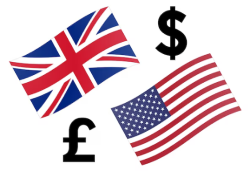
Flexity Analysis for GBPUSD
Forecast Overall(Short-Term, Long-Term): ST=Undecided LT=Strong Down
Forecast Methods(Short-Term, Long-Term):
[Method0] ST=Same LT=Down
[Method1] ST=Up LT=Down
[Method2] ST=Down LT=Down
FlexityIndicator Analysis Method(0)
Short-Term: **Short-Term Forecast for GBP/USD: Range-Bound Movement** Based on the analysis provided, the GBP/USD pair is projected to exhibit a short-term range-bound behavior, with no strong indication of an upward or downward trend. Here's the breakdown: 1. **Price Movement**: The recent decline and intraday fluctuation suggest minor volatility without significant direction. 2. **Trend Analysis**: A horizontal trend with a high probability of remaining between $1.32 and $1.37 indicates potential sideways movement. 3. **Technical Indicators**: Mixed signals—bullish indicators like the pivot buy and MACD, versus a long-term bearish moving average—suggest caution. 4. **Support and Resistance**: The support at $1.33 is near current levels, offering a potential buying opportunity if tested, while resistances at $1.35 and $1.37 may limit upward movement. 5. **Volume and Liquidity**: Declining volume with low liquidity poses some risk but still confirms the positive trend. 6. **Intraday Forecast**: A tight swing range suggests minor fluctuations, aligning with a neutral stance. **Conclusion**: The outlook is neutral, leaning towards holding and monitoring market developments closely. There's no immediate signal for buying or selling; thus, the short-term expectation is for the price to remain within a defined range without significant direction. Long-Term: **Long-Term Outlook for GBP/USD:** Based on the analysis provided, the long-term outlook for GBP/USD suggests a cautious bearish stance with moderate expectations. Here's the breakdown: 1. **Price Forecast:** The short-term projection indicates a narrow range of $1.32 to $1.37, suggesting limited movement and stability. 2. **Trend and Resistance:** While there is potential for a breakout, the long-term moving average (resistance at $1.35) may cap upward movements, indicating possible downward pressure in the longer term. 3. **MACD Analysis:** The mixed signals from MACD—buy signal divergence but an overarching sell due to long-term MA above short-term—hint at underlying bearish momentum despite some bullish indicators. 4. **Market Sentiment and Volatility:** The upgrade from "sell" to "hold" indicates a less negative outlook, but combined with controlled volatility, it suggests gradual rather than sharp changes. Periods of low liquidity add risk but not a clear trend. **Conclusion:** The long-term expectation leans towards a bearish trend due to the sell signal and resistance levels, though within a range and with potential for fluctuation. The overall sentiment upgrade to "hold" adds caution, suggesting GBP/USD may decline moderately over time.
Result: [Method0] ST=Same LT=Down
FlexityIndicator Analysis Method(1)
Short-Term: **Answer:** The GBP/USD exchange rate is expected to **go up** in the short term, as indicated by the ING Forecast predicting an advance towards 1.36/1.38. Factors such as positive US retail sales data maintaining stability and anticipation of favorable UK jobs and US inflation data suggest an upward trend despite potential volatility from economic indicators. Long-Term: **Analysis of GBP/USD Long-Term Outlook:** Based on the comprehensive analysis of factors influencing the GBP/USD exchange rate, the outlook suggests a **bearish trend** in the long term. Key considerations include: 1. **ING Forecast (July 2025):** While ING predicts a potential target range of 1.36-1.38, indicating cautious optimism, this is slightly above the current rate but does not account for significant downside risks. 2. **Bearish Scenario:** The risk of GBP/USD dropping to 1.20 is substantial due to factors such as Fed rate hikes strengthening the USD and weak global demand, which can exert downward pressure on the pound. 3. **Economic Indicators:** Poor UK economic data, particularly in areas like jobs and inflation, pose risks for the pound, potentially leading to its weakening. 4. **Central Bank Policies:** The Fed's ongoing rate hikes are likely to continue strengthening the USD, outweighing any potential support from the BOE unless it adopts a significantly more hawkish stance. 5. **External Factors:** Geopolitical risks and oil price volatility add to market uncertainty, potentially exacerbating downward pressures on GBP/USD. **Conclusion:** While there is some optimism for a slight upward movement, the dominant factors suggest a bearish trend with significant potential for a drop to 1.20 in the long term. Therefore, the overall outlook is **downward**.
Result: [Method1] ST=Up LT=Down
FlexityIndicator Analysis Method(2)
Short-Term: Based on the analysis of the provided information and market factors, the expected short-term movement for GBP/USD is **down**. This outlook considers the current downward trend, upcoming key events that may weaken the pound, and potential strengthening of the USD due to inflation data and market sentiment shifts. Answer: The price for GBP/USD is expected to go down in the short term. Long-Term: **Analysis of GBP/USD Price Expectation:** Based on the provided context, here's a structured analysis: 1. **Current Market Movement**: The GBP has weakened slightly, dropping from $1.345 to $1.341 and currently at 1.3425, indicating a downtrend. 2. **BoE Policy Considerations**: - Recent rate cut by the BoE (25 bps to 4%) with internal opposition suggests cautious optimism. - Sticky inflation may lead to a slowdown in easing, potentially affecting GBP strength. 3. **Key Economic Events**: - Upcoming UK GDP data could impact GBPUSD; weaker GDP might weaken GBP. - US CPI and potential Fed policy changes are critical; stronger Fed action could strengthen USD, weakening GBP/USD. 4. **Market Sentiment**: - Market caution suggests volatility and possible downward pressure as investors remain nervous. **Conclusion**: The short-term outlook for GBP/USD is expected to go down due to current market weakness, potential Fed tightening, and uncertain UK economic data. Long-term trends depend on broader economic factors but are less certain in this context.
Result: [Method2] ST=Down LT=Down
